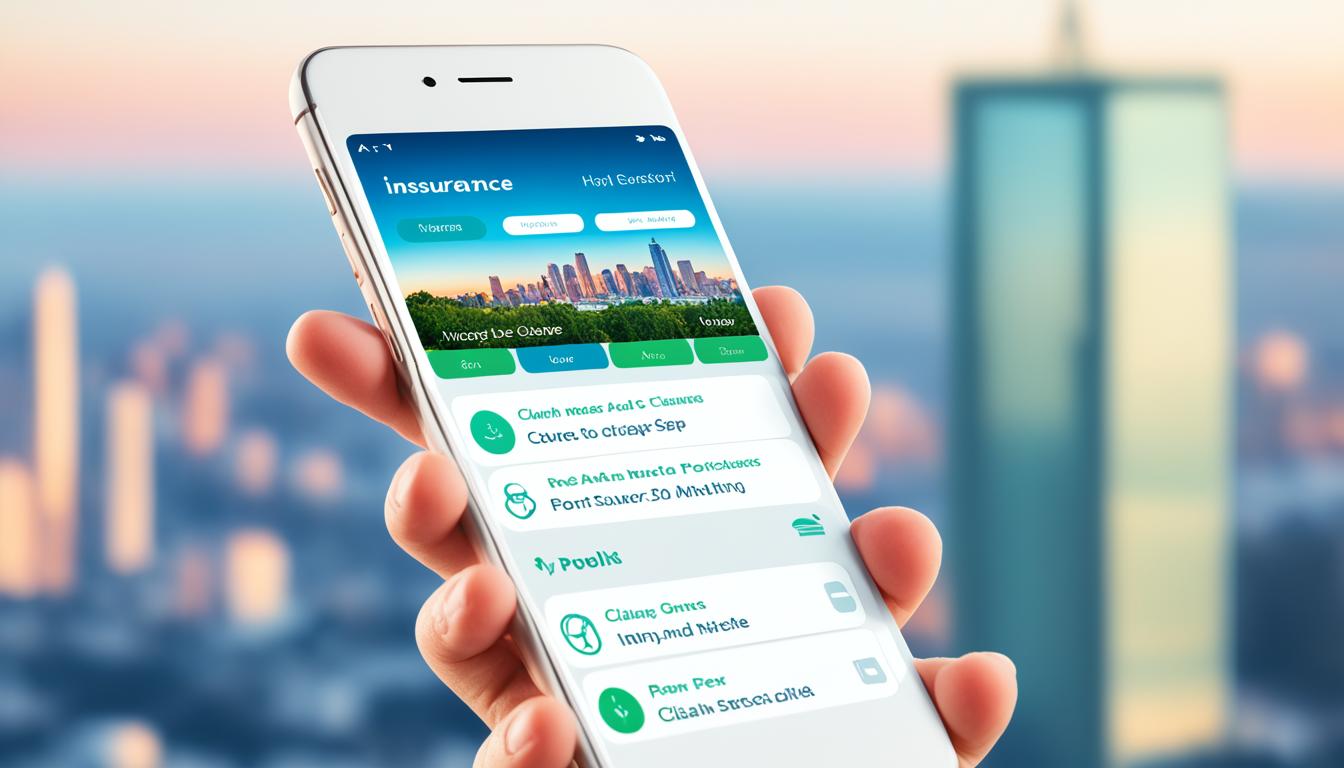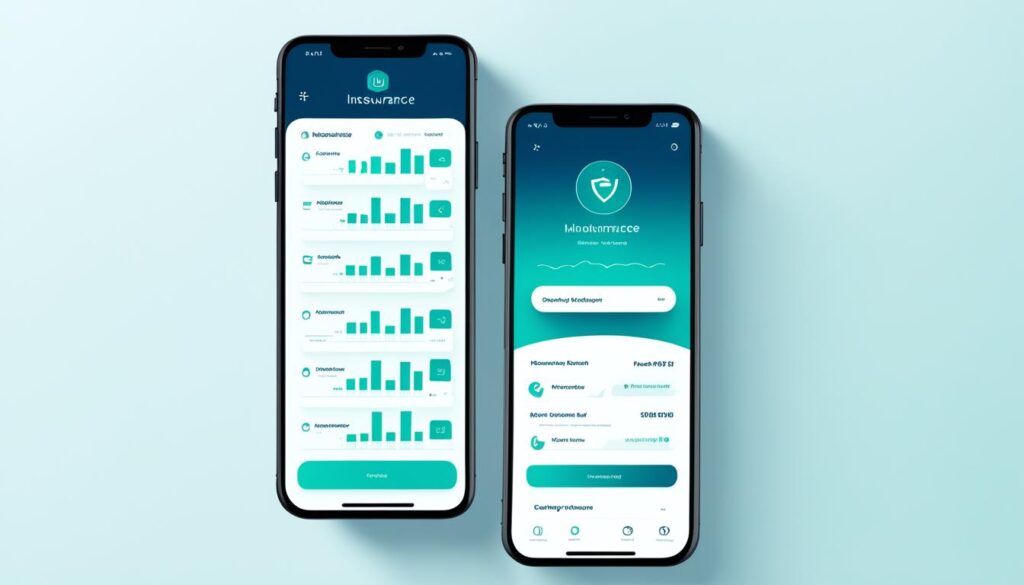The insurance industry is changing fast, making mobile app development key to improving user experience. Customers want more from their insurance companies, leading to a big push for digital solutions. This article looks at how making innovative insurance mobile apps can boost policyholder engagement and help businesses grow.
Table of Contents
Key Takeaways
- Understand the rising importance of mobile apps in the insurance industry and their impact on customer experience.
- Explore the key features and functionalities that define successful insurance mobile apps.
- Discover the critical role of user experience in building trust, loyalty, and customer satisfaction.
- Leverage data analytics and user insights to design intuitive and personalized mobile interfaces.
- Integrate emerging technologies, such as AI and AR, to enhance the overall mobile app experience.
- Ensure robust data security and privacy measures to instill confidence in policyholders.
- Adopt agile development methodologies and comprehensive testing strategies for continuous improvement.
The Rise of Mobile Apps in the Insurance Industry
The insurance industry has seen a big jump in mobile app use. Customers now want easy, on-the-go access to their insurance and services. This change comes from new customer wants and the need for digital-first experiences.
Changing Customer Expectations
Today, insurance customers look for smooth, easy digital experiences that fit their needs. They want to handle their policies, file claims, and get info from their phones easily. This shift has made insurers put money into mobile apps in insurance to meet these new customer expectations.
The Need for Convenient Access
The growth of digital engagement in insurance comes from customers wanting easy, on-the-go access. They don’t want to use old ways like going in person or using computers. They want quick, self-help insurance customer experience to manage policies and make transactions anytime, anywhere.
| Feature | Benefit |
|---|---|
| Instant Policy Access | Customers can view and manage their insurance policies with ease, reducing the need for physical paperwork. |
| Seamless Claims Filing | Customers can file claims and track their status directly from their smartphones, streamlining the claims process. |
| Real-time Updates | Customers receive timely notifications and updates on their policies, claims, and other important information. |
The insurance industry’s move to mobile apps in insurance is a smart way to meet new customer expectations and offer easy, digital-first insurance customer experience. By giving customers accessible, easy-to-use mobile apps, insurers can improve digital engagement and serve their customers better.
Key Features of Successful Insurance Mobile Apps
Mobile apps are now key in the fast-changing insurance world. They make the user experience better. They have a smooth user interface that’s easy to use. They also let users make the app their own, which makes them happier and more involved.
Seamless User Interface
The design of an insurance app’s user interface is very important. It should be clean and simple, making it easy for users to find what they need. It should also work well on different devices and sizes.
Personalization and Customization
Insurance apps that let users make the app their own do well. By letting users change the app to fit their needs, like customizing the dashboard or setting up alerts, the app becomes more useful. This makes the user experience better.
“The key to a successful insurance mobile app lies in its ability to seamlessly integrate with the user’s needs and preferences, creating a personalized experience that fosters loyalty and engagement.”
By focusing on a smooth user interface and personal features, insurance apps can stand out. They give users a digital experience that’s easy, convenient, and keeps them interested and happy.
Insurance Mobile App Development: Enhancing User Experience
The development of mobile apps has changed the game for the insurance industry. By investing in insurance mobile app development, companies can make a platform that is easy to use and meets their customers’ needs. This approach makes the user experience better and strengthens the connection between the insurer and the insured.
Understanding what modern consumers want is key to making a successful insurance mobile app. Today, people want things to be easy, personalized, and quick to access. By adding these features, insurance companies can make apps that really connect with their audience.
Intuitive Navigation and Seamless Functionality
A good insurance mobile app should make it easy to find policy details, file claims, and manage accounts. Users should be able to do these things with just a few taps on their phones. The app should be clean and easy to use for a smooth experience.
Personalized Experiences and Customization
In the insurance world, making things personal is crucial for strong customer relationships. Insurance apps should let users set their own preferences, get reminders, and see recommendations that fit their insurance needs. This personal touch makes the experience better and builds trust and loyalty with customers.
“Developing an insurance mobile app that truly understands and caters to the needs of policyholders is essential in today’s digital landscape.”
By focusing on these key areas, insurance companies can make a platform that puts the customer first. Using cutting-edge technologies and a customer-driven approach can lead to growth, customer happiness, and success in the insurance industry.
The Importance of User Experience in Insurance Apps
In the insurance world, building trust and loyalty is key. The way mobile apps work is crucial. A good app makes customers happy and builds trust with insurers.
Building Trust and Loyalty
A smooth app experience helps build trust and loyalty. When customers find the app easy to use, they see the insurer as reliable. This makes them trust and feel closer to the company, leading to loyalty.
Improving Customer Satisfaction
Putting user experience in insurance apps first can really boost customer satisfaction. When people can easily manage their policies or file claims on their phones, they feel more in control. This leads to more trust and loyalty towards the insurer.
Creating a user-focused insurance app is smart for insurers. It helps them stand out, engage with customers better, and grow their business. By making apps easy and fun to use, insurers can build strong customer relationships and stay ahead in the market.
Understanding User Behavior and Preferences
To make a successful insurance mobile app, it’s key to know what users like and how they act. By using data and insights, insurance companies can make apps that meet the needs of their customers. This makes the app better for everyone.
Data Analytics and User Insights
Looking at user data is vital for finding important insights. Insurance companies can use data analytics to see how users act, what they like, and what troubles them. This helps them decide on the app’s features, design, and how it works. This way, the app stays useful and meets the needs of its users.
| User Behavior Metrics | User Preference Insights |
|---|---|
|
|
By using what we know about user behavior and preferences, insurance companies can make apps that are truly personal and engaging. This leads to happier users, more loyalty, and trust.
“Successful insurance mobile apps are built on a deep understanding of user preferences and behaviors, which can only be achieved through comprehensive data analytics and thoughtful user research.”
Designing Intuitive Navigation and Interfaces
Making an intuitive navigation and user interface design is key for great mobile app usability in insurance apps. By focusing on easy-to-use experiences, insurance companies help policyholders easily access and manage their coverage.
Designing intuitive insurance apps means having a clear and logical navigation structure. This means organizing content so it matches what users expect and helps them find what they need fast.
- Use a menu system that’s easy to follow with clear labels.
- Use visual hints and signs to help users navigate the app.
- Make the app easy to use with one hand and gestures, perfect for on-the-go.
The user interface design is also vital for a great mobile experience. Insurance companies should aim for interfaces that look good and work well.
| Design Element | Best Practices |
|---|---|
| Typography | Choose fonts that are easy to read on small screens. |
| Color Palette | Use a color scheme that matches the brand and helps with reading. |
| Iconography | Use icons that are clear and catch the eye to represent important features. |
By focusing on intuitive navigation and user interface design, insurance companies can make mobile app usability that lets policyholders manage their coverage easily and with confidence.
“Seamless user experiences are essential in building long-term trust and loyalty with insurance customers.”
Integrating Emerging Technologies
The insurance industry is quickly adopting emerging technologies to make their mobile apps better. They’re using artificial intelligence, chatbots, augmented reality, and virtual reality. These new techs are changing how people deal with their insurance companies.
Artificial Intelligence and Chatbots
Insurance mobile apps are now using artificial intelligence to make things easier and more personalized for customers. Chatbots can answer many questions, like about policies and claims, any time of the day. This makes customers happier and lets insurance workers focus on harder tasks.
Augmented Reality and Virtual Reality
Augmented reality and virtual reality are changing how people look at their insurance. Now, customers can see and touch their insured things, like homes or cars, in a virtual world. This helps them understand risks and what they need for coverage. It also builds trust and loyalty with the insurance company.
| Emerging Technology | Application in Insurance Mobile Apps |
|---|---|
| Artificial Intelligence | Chatbots for customer support, personalized recommendations, and claims processing |
| Augmented Reality | Virtual inspection of insured assets, interactive policy information, and risk assessment |
| Virtual Reality | Immersive experience for exploring policy coverage, risk management, and customer engagement |
The insurance world is always changing, and using emerging technologies is key to a great user experience. By using artificial intelligence, chatbots, augmented reality, and virtual reality, insurance companies can offer new solutions that meet what customers want.
Ensuring Data Security and Privacy
Insurance mobile apps deal with sensitive customer info. It’s crucial to keep this data safe and private. Providers must use strong security steps to protect policyholder info and keep users’ trust.
Data encryption is key for app security. It should encrypt personal, financial, and claims history data with top-notch algorithms. This makes the data unreadable to anyone who shouldn’t see it.
Multi-factor authentication is also vital. It makes users prove who they are with extra checks like a scan or a code. This boosts the security of user accounts and stops others from getting in.
| Security Feature | Importance | Example |
|---|---|---|
| Data Encryption | Protects sensitive information from unauthorized access | AES-256 encryption for all personal and financial data |
| Multi-factor Authentication | Verifies user identity and prevents unauthorized access | Fingerprint or facial recognition, along with a unique passcode |
| Secure Data Storage | Ensures that data is stored safely and in compliance with regulations | Storing data in encrypted databases with restricted access |
Insurance mobile apps should also focus on secure data storage. This means keeping data in encrypted places that only certain people can get to. It helps stop unauthorized access and follows data privacy laws.
By focusing on data security and data privacy, insurance companies can gain their customers’ trust. They can offer a safe and dependable app experience.
The Role of Agile Development Methodologies
In the fast-paced world of insurance mobile app development, agile development is key. It supports iterative development and continuous improvement. This helps meet the changing needs of users and market demands.
Iterative Development and Continuous Improvement
Methods like Scrum and Kanban focus on iterative development and continuous improvement. They break the development into smaller parts. This lets teams quickly adjust to feedback and new needs. It keeps the insurance mobile app development focused on users.
This way, apps can quickly add new features. Insurance companies can stay ahead and offer top-notch mobile experiences.
- Use agile development to support iterative development and continuous improvement
- Divide the work into smaller parts for quick changes based on feedback
- Use rapid prototyping, testing, and deployment to keep the insurance mobile app relevant
By being agile, insurance companies can keep their apps leading the industry. They deliver great user experiences, increase customer satisfaction, and build loyalty.
Testing and Quality Assurance Strategies
Testing and quality assurance are key for making sure insurance mobile apps work well and are reliable. These steps check the app’s features, how users feel about it, and its security before it goes live. This helps keep the user’s trust and satisfaction high.
Testing includes many methods, like functional testing to check main features, usability testing to see if it’s easy to use, and security testing to find and fix security issues. With a detailed testing framework, insurance companies can make sure their apps give a top-notch experience to their customers.
- Functional Testing: Make sure the app’s main features and workflows work as they should.
- Usability Testing: Check how easy the app is to navigate, its design, and how users feel about it.
- Security Testing: Find and fix security risks, like data breaches, to keep user info safe.
- Performance Testing: See how the app performs under different conditions, like heavy use.
- Compatibility Testing: Make sure the app works well on various devices, systems, and screen sizes.
By using a thorough quality assurance strategy, insurance companies can create insurance mobile apps that build trust, improve user happiness, and increase customer loyalty in the competitive insurance market.
Marketing and Promoting Insurance Mobile Apps
Marketing and promotion are key to getting more people to use insurance mobile apps. By making the app more visible in app stores and using social media and digital marketing, insurers can connect better with their customers.
App Store Optimization (ASO)
App Store Optimization (ASO) is vital for making your insurance app easy to find in app stores. It means making the app’s title, description, keywords, and visuals better. This helps the app show up higher in searches and be seen more often.
Doing deep keyword research and writing great app listings helps more people find your app when they look for insurance solutions on their phones.
Social Media and Digital Marketing
Social media and digital marketing are great ways to promote your insurance app. You can use Facebook, Instagram, and LinkedIn to run ads that target the right people. Also, talking with customers on social media, sharing useful info, and answering their questions can make them more loyal and encourage them to download your app.
Adding email marketing, content marketing, and SEO can make your digital marketing even stronger. This way, your insurance app gets noticed online in more places.
| Marketing Strategy | Key Benefits |
|---|---|
| App Store Optimization (ASO) | Improved app visibility and discoverability in app stores |
| Social Media Marketing | Targeted reach, brand engagement, and customer acquisition |
| Content Marketing | Increased website traffic, lead generation, and thought leadership |
| Email Marketing | Personalized communication, customer retention, and loyalty |
Using a full marketing plan that includes app store optimization, social media, and digital marketing can help insurers promote their mobile apps well. This approach can lead to more users and better engagement over time.
Conclusion
This article looked at how insurance mobile apps improve the user experience for policyholders. By focusing on what customers want and adding key features, insurers can make apps that build stronger relationships. These apps also make customers happier and more loyal.
Using new tech like artificial intelligence and augmented reality makes insurance apps better. They offer personalized experiences and make things easier for users. Insurers can keep improving their apps by using data and agile development. This keeps their apps relevant and in line with customer needs.
The insurance industry is going digital, and making apps that focus on users is key. This helps insurers stay ahead and meet what modern customers want. By focusing on the user, insurers can gain trust, increase loyalty, and be seen as reliable partners in the changing insurance world.













